Service integrity KPIs (Key Performance Indicators) are crucial for assessing the quality of service provided to UEs (User Equipment) in an E-UTRAN (Evolved Universal Terrestrial Radio Access Network). These KPIs cover various aspects of network performance, including throughput, packet loss rates, and error rates, and are essential for ensuring a high-quality user experience.
LTE Service Integrity KPIs.
1. User Downlink Average Throughput.
This KPI measures the average downlink throughput experienced by a UE in a cell. According to 3GPP TS 32.450, the throughput measurement should exclude the data scheduled in the last TTI before the downlink buffer is empty to provide an accurate assessment.


Definition: The User Downlink Average Throughput KPI is defined in Table below and is calculated based on the total downlink traffic volume, excluding the data scheduled in the last TTI before the downlink buffer is empty, and the downlink data transmission duration, excluding the last TTI before the downlink buffer is empty.
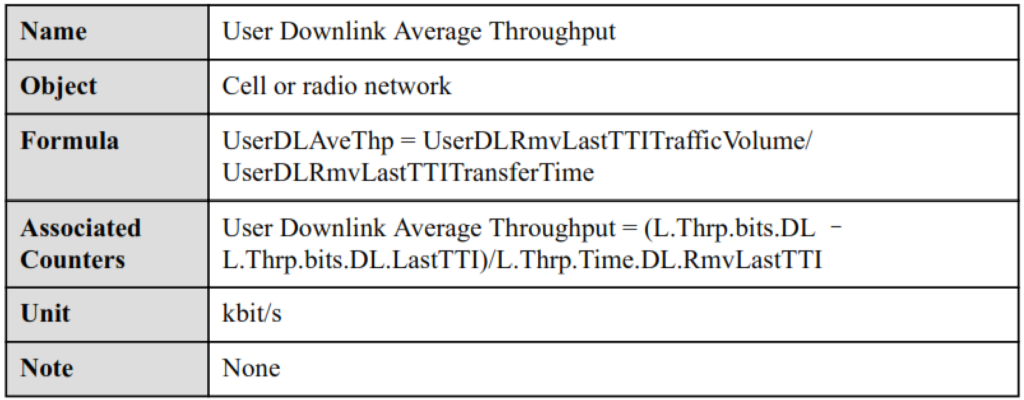
2. User Uplink Average Throughput.
This KPI measures the average uplink throughput experienced by a UE (User Equipment) in a cell. The measurement excludes the data scheduled in the last Transmission Time Interval (TTI) before the uplink buffer is empty to ensure an accurate reflection of throughput.
Definition: The User Uplink Average Throughput KPI for Frequency Division Duplex (FDD) and Time Division Duplex (TDD) modes is defined in Table below.
Formula: The formula for User Uplink Average Throughput would be:
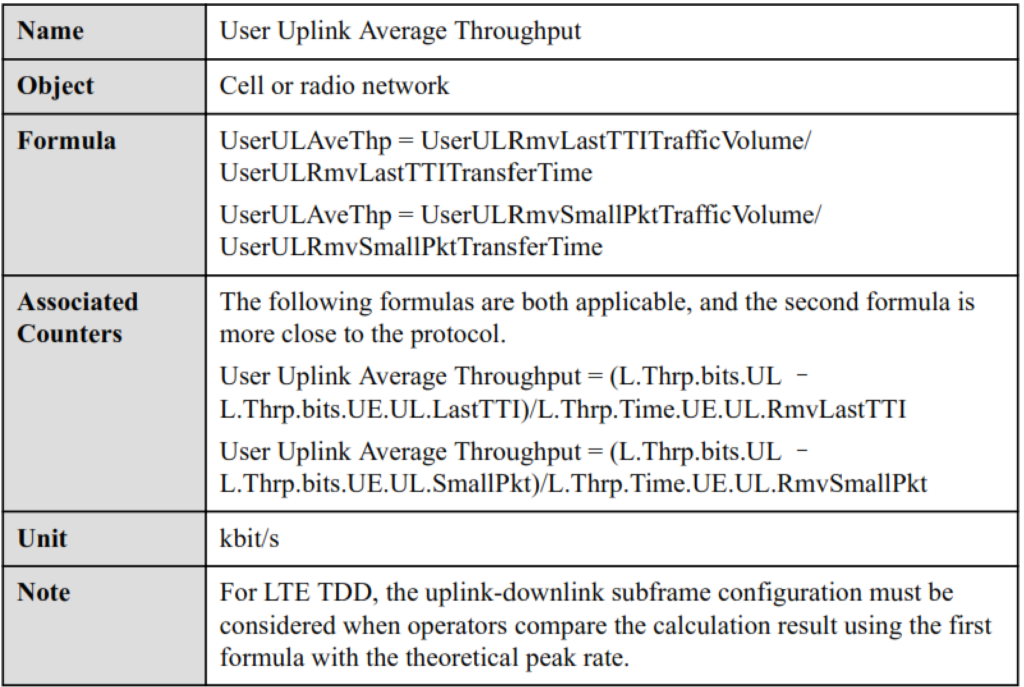
3. Service Downlink Average Throughput.
This KPI measures the busy-hour downlink throughput for a service with a specific QCI per user in each cell. There are nine sub-KPIs, each corresponding to one of the nine QCIs. This KPI reflects the end-user experience during peak usage times.

Definition: The Service Downlink Average Throughput KPI is defined in Table below. Like the uplink throughput KPI, it consists of nine sub-KPIs, each mapped to a specific QCI. The formula for each sub-KPI is mapped to specific counters that track these metrics.
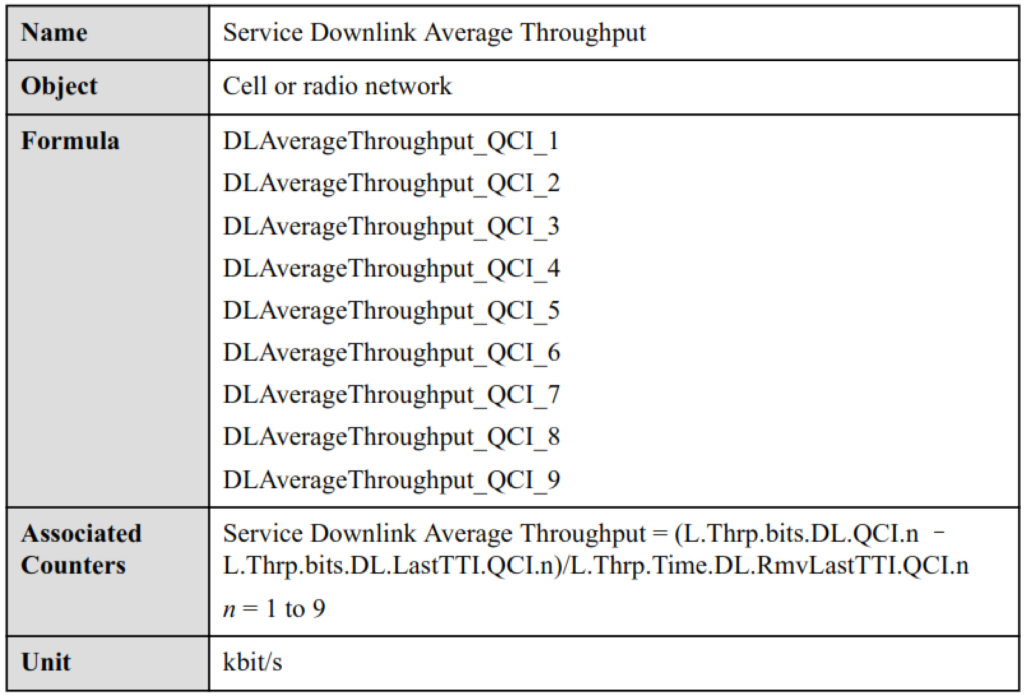
4. Service Uplink Average Throughput.
This KPI measures the busy-hour uplink throughput for a service with a specific QCI (QoS Class Identifier) per user in each cell. There are nine sub-KPIs, each corresponding to one of the nine QCIs. This KPI provides insights into the end-user experience during peak usage times.
Definition: The Service Uplink Average Throughput KPI is defined in Table below and is calculated for each of the nine QCIs. The formula for each sub-KPI is mapped to specific counters that track these metrics.
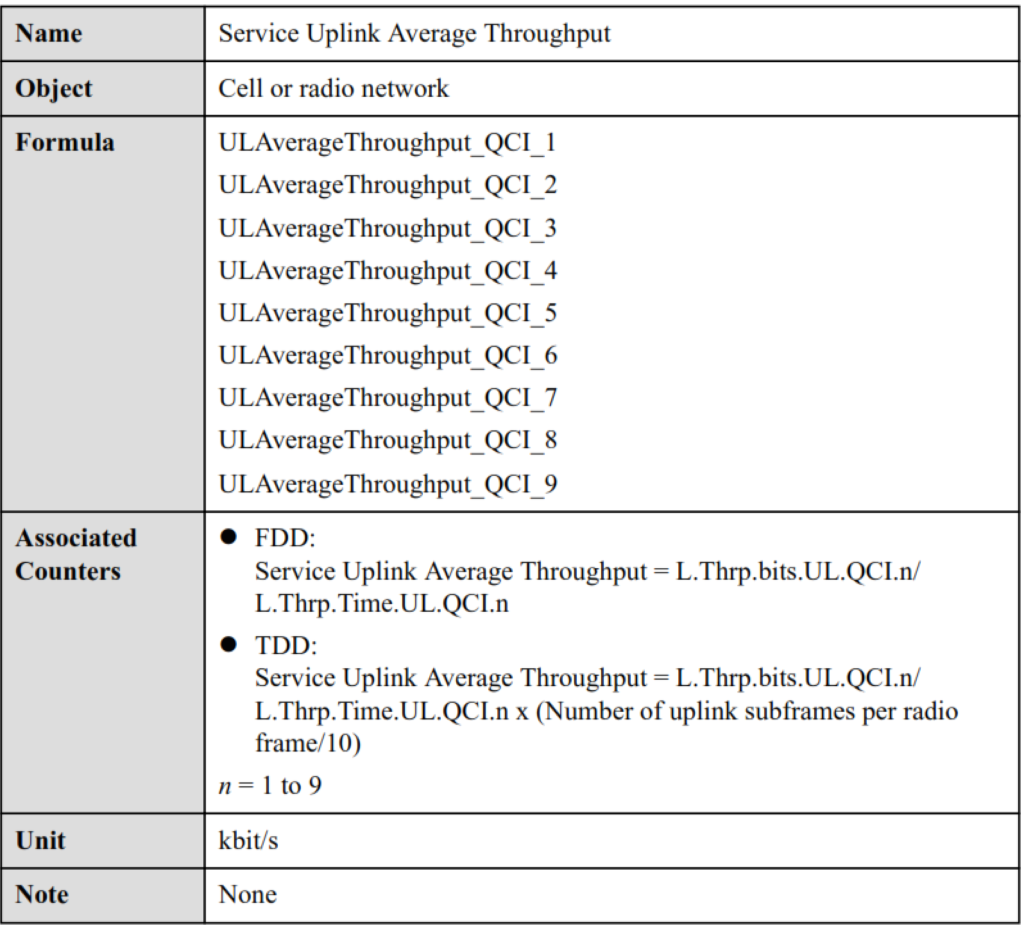
5. Cell Downlink Average Throughput.
This KPI measures the average downlink throughput of a cell. It reflects the cell’s capacity to handle downlink data transmission, providing insights into the cell’s performance and capacity.
Definition: The Cell Downlink Average Throughput KPI is calculated based on the total amount of data transferred in the downlink direction and the duration of this data transfer. The formula is mapped to specific counters that track these metrics.
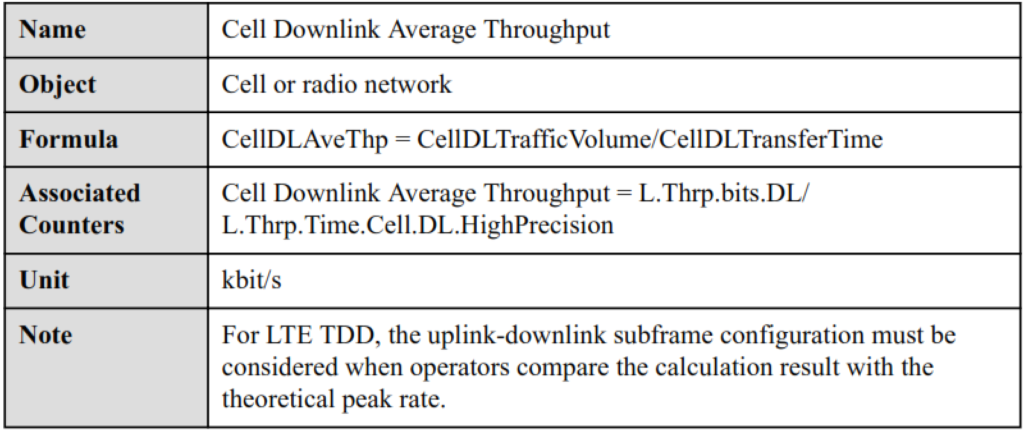
6. Cell Uplink Average Throughput.
This KPI measures the average uplink throughput of a cell. It reflects the cell’s capacity to handle uplink data transmission, which is crucial for understanding the cell’s performance and capacity.
Definition: The Cell Uplink Average Throughput KPI is calculated based on the total amount of data transferred in the uplink direction and the duration of this data transfer. The formula is mapped to specific counters that track these metrics.

7. Downlink Packet Loss Rate.
This KPI measures the overall packet loss rate in the downlink direction at the PDCP layer. It evaluates the quality of data transmission by considering all services with various QCIs, including PTT services and extended QCIs.
Definition: The Downlink Packet Loss Rate KPI is defined by the following formula:

8. Downlink Packet Loss Rate (VoIP).
This KPI measures the packet loss rate for VoIP services in the downlink direction at the PDCP layer. It focuses on the quality of VoIP data transmission by evaluating the number of lost PDCP SDUs for services using the QCI of 1.
Definition: The Downlink Packet Loss Rate (VoIP) KPI is defined by the following formula:

9. Uplink Packet Loss Rate.
This KPI measures the overall packet loss rate in the uplink direction at the PDCP layer. It evaluates the quality of data transmission by considering all services with various QCIs, including Push-to-Talk (PTT) services and extended QCIs.
Definition: The Uplink Packet Loss Rate KPI is defined by the following formula:
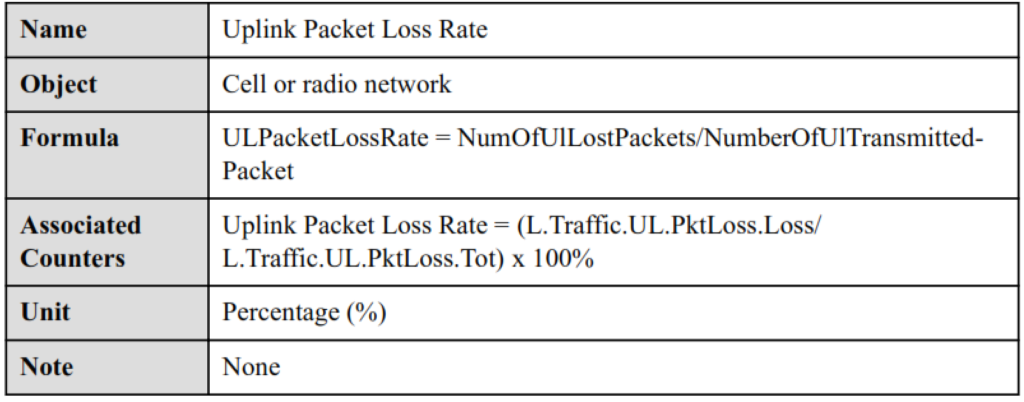
10. Uplink Packet Loss Rate (VoIP).
This KPI measures the packet loss rate for Voice over IP (VoIP) services in the uplink direction at the Packet Data Convergence Protocol (PDCP) layer. It focuses on the quality of VoIP data transmission by evaluating the number of dropped PDCP Service Data Units (SDUs) for services using the QoS Class Identifier (QCI) of 1, which is typically used for VoIP.
Definition: The Uplink Packet Loss Rate (VoIP) KPI is defined by the following formula:

11. Downlink Residual Block Error Rate (eMTC)
This KPI measures the residual block error rate for Enhanced Machine-Type Communication (eMTC) user equipment (UEs) in a cell’s downlink. It focuses on the quality of data transmission by evaluating how often data blocks (Transport Blocks, TBs) fail to be successfully transmitted despite maximum retransmission efforts on the Downlink Shared Channel (DL-SCH).
The Downlink Residual Block Error Rate (eMTC) KPI is calculated using the following formula:
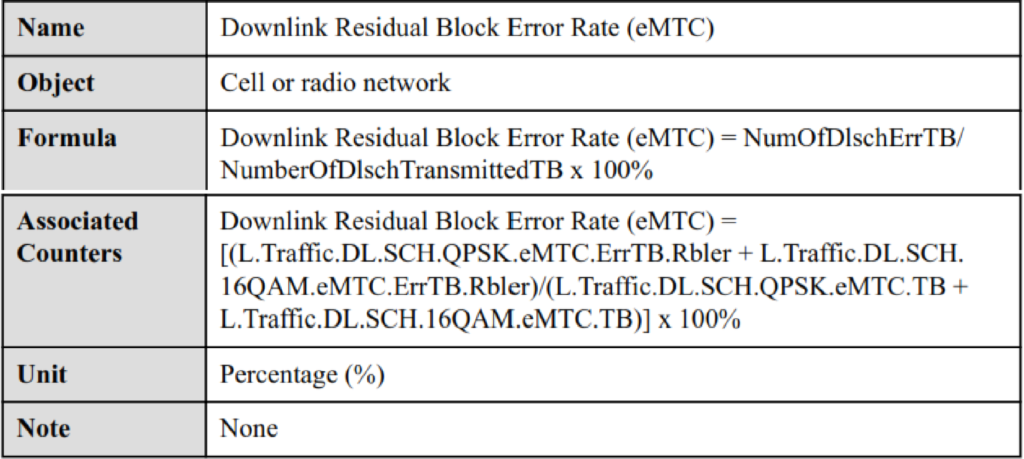
12. Uplink Residual Block Error Rate (eMTC).
This KPI measures the residual block error rate for eMTC UEs in a cell’s uplink. It evaluates the quality of data transmission by assessing how often TBs fail to be successfully transmitted despite maximum retransmission attempts on the Uplink Shared Channel (UL-SCH).
The Uplink Residual Block Error Rate (eMTC) KPI is calculated using the following formula:

13. User Downlink Split Average Throughput (NSA DC).
This KPI measures the average downlink split throughput for Non-Standalone Dual Connectivity (NSA DC) UEs in a cell. It provides an indication of the downlink data rate experienced by users connected to both LTE and 5G networks simultaneously. According to 3GPP TS 32.450, the measurement excludes the data scheduled in the last Transmission Time Interval (TTI) before the downlink buffer is empty to avoid skewing the results with incomplete transmissions.
The User Downlink Split Average Throughput (NSA DC) KPI is defined as the ratio of the total downlink traffic volume to the total downlink data transmission duration, both excluding the data scheduled and the time associated with the last TTI before the downlink buffer is empty.

14. User Uplink Split Average Throughput (NSA DC).
This KPI measures the average uplink split throughput for NSA DC UEs in a cell. Table below shows The User Uplink Split Average Throughput (NSA DC) KPI.
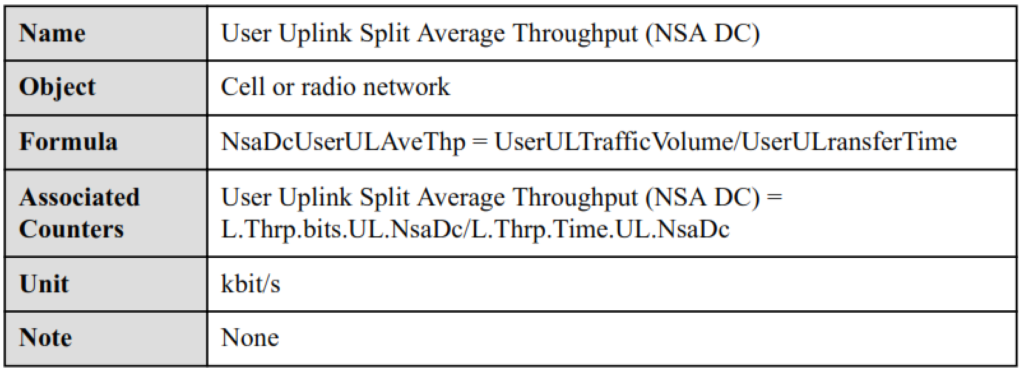
Summary
Service integrity KPIs provide comprehensive insights into the quality of service delivered by LTE networks. By monitoring these KPIs, operators can identify and address performance issues, ensuring optimal service delivery and enhanced user satisfaction.